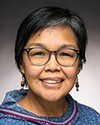My name is Byron Louis. I'm the chief of the Okanagan Band. It's a pleasure to be here. I'm sitting in Syilx territory in the province of British Columbia.
I'm not going to be covering the same ground as what was spoken on earlier about that, but I'd like to really talk about the actual core and foundation, if we are talking about restitution of land to first nations, Inuit and Métis.
Are we also talking about the whole issue of reconciliation? The view we take on reconciliation is the definition that talks about reconciliation being the resumption of good relations after a period of hostility. I think that really defines what our relationship has been for the longest period of time.
My question is this: How do we get beyond that? I think when we go back into that, we really need to look at what the foundation is. A lot of people don't recognize that fact, and I would ask the panellists, who have some of this research to be done.
In particular, it goes back to about 1537, with the signing of the Sublimis Deus—or the Sublimis Dei—by Pope Paul III. This document is important because it was about 45 years after Columbus had touched foot in Hispaniola and about 16 years after Cortés came ashore in 1519.
It recognized that we were in fact human beings, and not only were we human beings—and not beasts—but we were also recognized as being rational human beings and as having the right not to be deprived of our liberty or possession. Now, it is a document of colonization, but it recognizes at that point that we were in fact human beings.
You go into some of the other ones that establish the relationship that existed between first nations or indigenous peoples and the government, or the Crown, if you want to call it that. You go into 1704 and the Mohegans v. Connecticut. That is very interesting, because that's the earliest case of taking forward a case for land tenure and also of management and control. Then, of course, we know about the Royal Proclamation of 1763.
Also, most importantly, one of the outcomes later in 1814 was the signing of the Treaty of Ghent, article 9, which talked about the resumption of our full rights that were held prior to the hostilities in 1811. Well, when we talk about those rights, we're talking about the full rights. We expressed those rights through trade. We expressed those rights through interaction and engagement with government. We expressed that in diplomacy with our neighbours and with the newcomers who came in.
When you look at these systems, you see that we're still talking about the issue of not only recognition but the relationship that actually existed. You go into British Columbia joining Confederation in 1871. In that article, British Columbia said that Indians and the lands reserved for Indians were a responsibility of the Dominion of Canada. However, it also recognized that.... I'll quickly read this to you:
The charge of the Indians, and the trusteeship and management of the lands reserved for their use and benefit, shall be assumed by the Dominion Government, and a policy as liberal as that hitherto pursued by the British Columbia Government shall be continued by the Dominion Government after the Union.
Now, this is important, because if you actually.... In the policy that exists underneath there, it goes on to say:
To carry out such policy, tracts of land of such extent as it has hitherto been the practice of the British Columbia Government to appropriate for that purpose, shall from time to time—
This is very important:
—be conveyed by the Local Government—
That means a province.
— to the Dominion Government in trust for the use and benefit of the Indians on application of the Dominion Government; and in case of disagreement between the two Governments respecting the quantity of such...land to be so granted, the matter shall be referred for the decision of the Secretary of State for the Colonies.
This is one of the highest levels in colonial government, but why is this important? It shows to us in British Columbia that responsibility for us and our lands is with the Dominion and not with the province, and that the conveyance of land from time to time.... You know, to us, lands were never considered static. Reserves are supposed to be under review to look at size and demographics and other factors and be adjusted from time to time.




